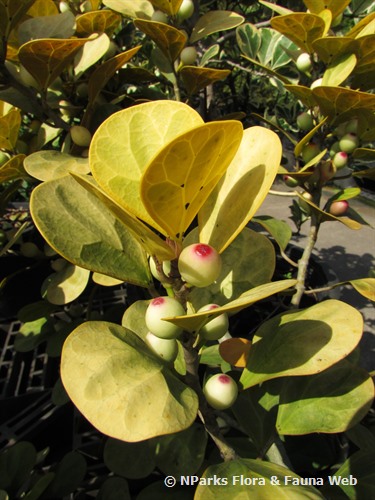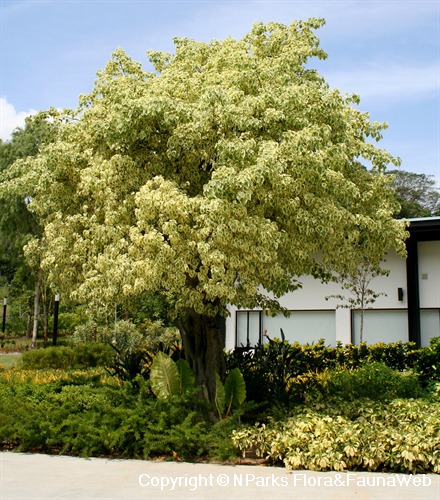.jpg)
Back
Ficus pumila L.
| Family Name: | Moraceae |
| Synonyms: | Ficus stipulata, Ficus longipedicellata |
| Common Name: | Creeping Fig, Climbing Fig, Creeping Ficus, Creeping Rubberplant, Ara Jalar, 薜荔 |
Name
Classifications and Characteristics
| Plant Division | Angiosperms (Flowering Seed Plants) (Dicotyledon) |
|---|---|
| Plant Growth Form | Climber |
| Lifespan (in Singapore) | Perennial |
| Mode of Nutrition | Autotrophic |
| Maximum Height | 2.5 m to 4 m |
| Maximum Plant Spread / Crown Width | 1.5 m to 2.5 m |
Biogeography
| Native Distribution | Southern China, Taiwan, Japan, Vietnam |
|---|---|
| Native Habitat | Terrestrial (Disturbed Area / Open Ground) |
| Preferred Climate Zone | Sub-Tropical / Monsoonal, Temperate |
Description and Ethnobotany
| Growth Form | Woody vine up to 4 m long with a climbing growth habit or trailing in the absence of vertical support. |
|---|---|
| Foliage | Egg-shaped leaves are 2-5 cm long on climbing vines, |
| Fruit | Purple, pear-shaped figs grow up to 5 cm long. |
| Cultivation | Prune regularly to encourage new growth with smaller leaves, and discourage mature woody, shrub-like growth. |
| Ethnobotanical Uses | Edible Plant Parts : Edible Fruits Medicinal: Stems and leaves used in Traditional Chinese Medicine as tonic and to treat fever. Leaves used in Japan in beverages to treat diabetes and high blood pressure. A decoction of fruits, stems and leaves are used to treat joint pain due to arthritis, rheumatism and sprains. Fruits said to promote lactation for mothers and cure impotency. Roots used to treat bladder problems and induce urination. |
Landscaping Features
| Landscaping | It is planted to cover walls and overhead bridges. |
|---|---|
| Landscape Uses | General, Vertical Greenery / Green Wall |
| Thematic Landscaping | Rockery / Desert Garden |
| Plant & Rootzone Preference or Tolerance Remarks | Able to cling and grow directly on natural and articial surfaces. |
Fauna, Pollination and Dispersal
| Fauna Pollination Dispersal Associated Fauna | Bird-Attracting |
|---|
Plant Care and Propagation
| Light Preference | Semi-Shade, Full Sun |
|---|---|
| Water Preference | Moderate Water |
| Plant Growth Rate | Moderate |
| Rootzone Tolerance | Easy to Grow, Disease / Pest Resistant, Shallow Media, Moist Soils, Well-Drained Soils, Fertile Loamy Soils |
| Maintenance Requirements | Low |
| Pruning | Prune regulary to restrict growth to desired locations (eg. from windows), encourage new growth with smaller leaves, and discourage aggressive woody growth and fruiting |
| Diseases | It is generally resistant to diseases. |
| Pest(s) | Sucking Insects |
| Propagation Method | Seed, Stem Cutting (Semi-Hardwood) |
| Planting Distance | 0 |
Foliar
| Foliage Retention | Evergreen |
|---|---|
| Mature Foliage Colour(s) | Green |
| Mature Foliage Texture(s) | Leathery, Rough |
| Prominent Young Flush Colour(s) | Red |
| Foliar Type | Simple / Unifoliate |
| Foliar Arrangement Along Stem | Alternate |
| Foliar Attachment to Stem | Sessile |
| Foliar Shape(s) | Non-Palm Foliage (Ovate) |
| Foliar Venation | Pinnate / Net |
| Foliar Margin | Entire |
| Foliar Apex - Tip | Acute |
| Foliar Base | Cordate |
| Typical Foliar Area | Microphyll ( 2.25cm2 - 20.25 cm2 ) |
Non - Foliar and Storage
| Stem Type & Modification | Woody |
|---|---|
| Root Type | Underground (Fibrous Root) |
Floral (Angiosperm)
| Flower & Plant Sexuality | Bisexual Flowers |
| Flower Size - Remarks | Very small, gathered on inner surface of synconium |
|---|---|
| Flowering Habit | Polycarpic |
Fruit, Seed and Spore
| Mature Fruit Colour(s) | Purple, Red |
|---|---|
| Fruit Classification | Simple Fruit |
| Fruit Type | Fleshy Fruit , Multiple Syconium (receptacle) |
Image Repository
Others
| Master ID | 107 |
|---|---|
| Species ID | 1403 |
| Flora Disclaimer | The information in this website has been compiled from reliable sources, such as reference works on medicinal plants. It is not a substitute for medical advice or treatment and NParks does not purport to provide any medical advice. Readers should always consult his/her physician before using or consuming a plant for medicinal purposes. |

.jpg)











